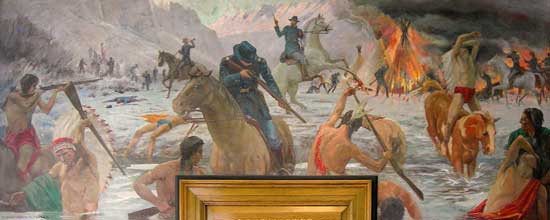
The Bear River Massacre Site. PHOTO: westerndigs.org
The narrative of Native American history in the United States is patchy at best. Many events have been lost to time, many simply stay locked within the closed communities dotted across the United States. But thanks to modern archaeology, many of these stories are coming into the public eye. Archaeologists think they may have pinpointed the location of the Bear Creek Massacre: a bloody morning in January, specifically January 29, 1863.
Colonel Patrick Edward Connor and about 200 California Volunteer Troops swooped down on a Northwestern Shoshone winter village located at the Beaver Creek and Bear River crossing in the Cache Valley, just north of the Utah-Idaho boundary. There were about 450 Shoshone gathered by the river. Among them were women, children, and babies. They’d gathered to winter there, to perform rituals to urge spring to come sooner, to tell stories and to hunt. Children had dug foxholes to play in down by the river, and it was to these that the Shoshone began to run when they saw the army headed for them.
The Shoshone were caught completely by surprise in early-morning darkness at 6:00 AM. They managed to kill twenty three of the American soldiers, but after that they ran out of ammo and it was nothing short of slaughter. The last two hours of the battle the soldiers used their revolvers to ride down and shoot all the Shoshone they could find. Old Chief Bear Hunter, the leader of the group, was whipped, kicked, and tortured until the soldiers ultimately shot him. Many undisciplined soldiers ran through the camp, using axes to finish off wounded children and raping the women they found before killing them, too.
At the end of it, an estimated 250 Shoshone were dead, including 90 women and children. One baby was found still alive up in the branches of a tree, where a parent had probably left it in a desperate bid for the child’s survival. Later, when settlers moved into the area, they found many more bodies in ravines or under deep snow, and that put the death count as high as 500. The Shoshone themselves estimate that more than 400 of their people were killed. Less than 60 survived that bloody morning.
But despite the brutality and widespread effect on the Shoshone tribe this massacre had, it is one of the least-known massacres in US History. The head archaeologist working on the site, Dr. Ken Cannon, hopes that in finding the exact location of the massacre and by starting to unearth the history of the area, it will make the story more accessible to the general public, and people will start talking more about the event.
Last year, the Idaho State Historical Society hired Dr. Ken’s team to conduct the first ever investigation about the Bear Creek Massacre. They wanted the site to be found so it could be commemorated as a historic battlefield.
The site has faded out of common knowledge because so much modern construction has happened in the area. All traces of the Shoshone village have been completely wiped out by layer after layer of modern infrastructure: railroads, canals, and federal highways.
Dr. Ken’s team drew on three historic maps drawn by witnesses of the massacre. They’ve been able to identify landmarks. The trouble is that farmland irrigation has diverted Bear Creek so many times that it has been nearly impossible to find the original riverbed the water ran through at the time the massacre occurred. Of course, the river itself is the most important landmark because that was where the village was. In order to find the original riverbed, Cannon’s team surveyed the land using GPR, or ground penetrating radar, magnetic gradiometer, and metal detectors.
These tools ended up helping them pick up the traces of the old Shoshone lodges using evidence that has long been the staple of archaeologists studying Native American history: rock alignments, hardened floors, and charcoal hearths. The archaeologist have had some success using these methods. One magnetometer image has a semicircle alignment that could be a lodge, but until they finish excavating, they can’t be sure. They started work on the site this spring, and they say that the hearths in this area created by the Shoshone date back more than 1,000 years. The ravine along Bear Creek was a winter gathering place for the tribe for centuries. The nearby ravine was more than likely the site of most of the deaths. The experts working on the site suspect the women and children fled along the bottom of the ravine and were shot down in crossfire from soldiers on both sides, turning the area into a bloodbath.
Archaeologists from Pocatello Preservation Committee at Idaho State University and experts from the Northwestern Band of the Shoshone nation are working together to uncover the history buried beneath the earth at this historic site.
“Nobody knows about these events. They’ve been lost, and yet they’re incredibly important. So if we are able to find physical remains, we may be more able to make this event more visible to the general public.” – Dr. Ken Cannon


